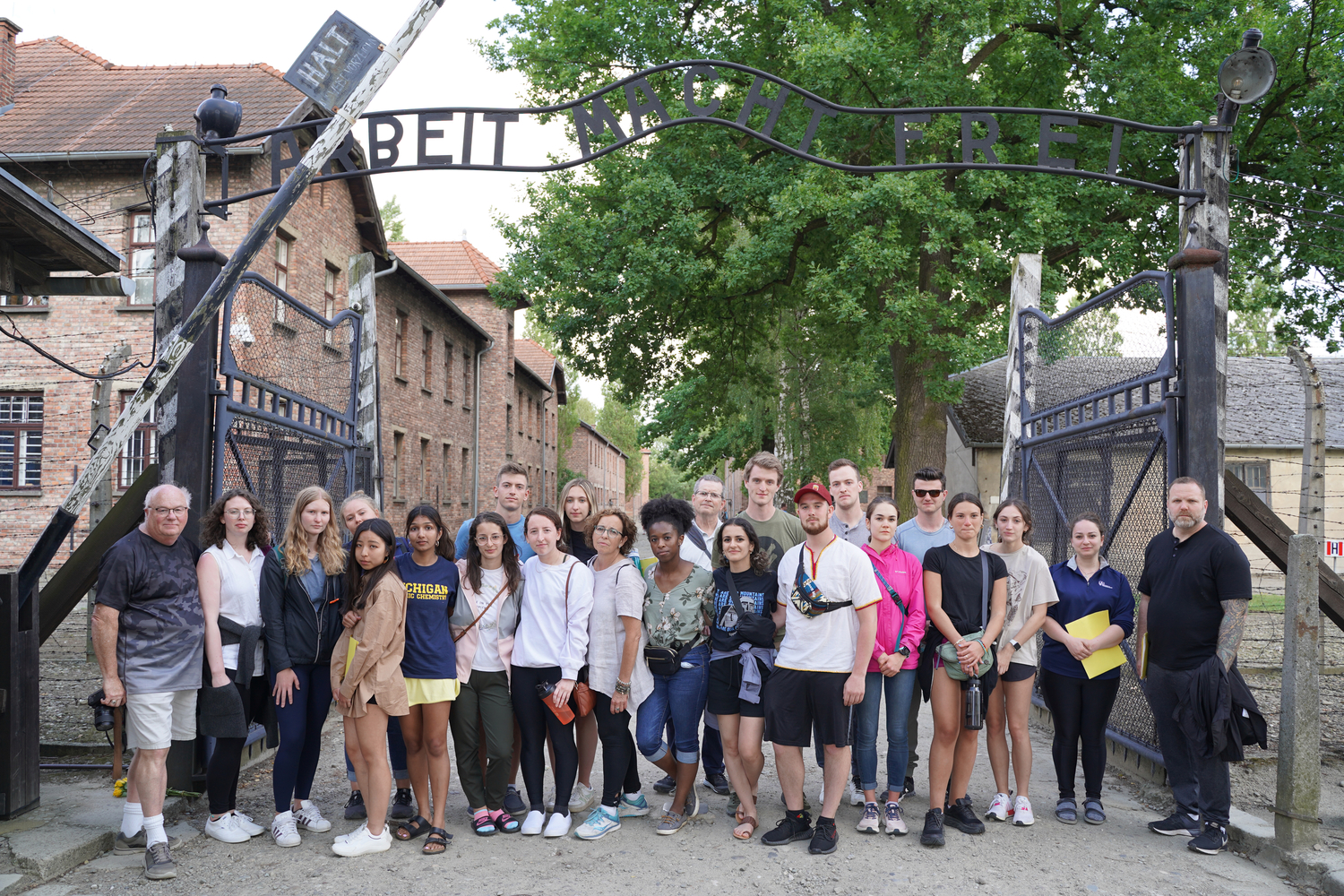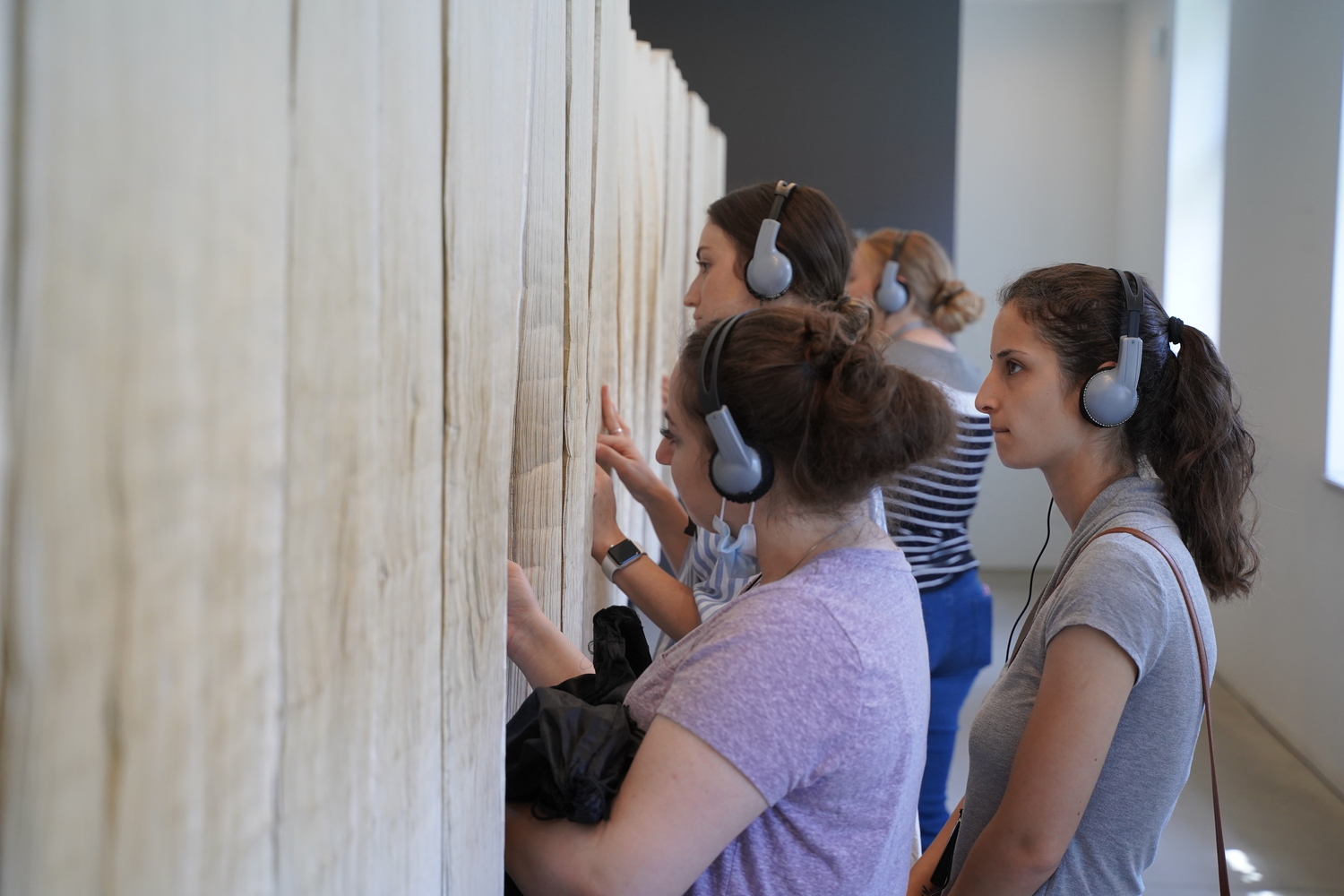
Nineteen next generation physicians from Oakland University William Beaumont School of Medicine spent last week in Poland for better understanding of the Holocaust — and gained deeper appreciation for human kindness.
The week consisted of two days in Krakow with the rest of the time spent in Oswiecim, home to the sites of the former Auschwitz 1 and Auschwitz-Birkenau concentration camps.
Students learned about Jewish heritage and history, the extent of the Holocaust and how physicians reacted on all sides, took part in reflective writing sessions, read testimonials, and began developing plans to share what they learned with others. The overall goal was to prompt students to reflect on the implications of the Holocaust for one’s own personal and professional development within the medical profession.
| CLICK HERE TO VISIT THE WEBPAGE DEDICATED TO OUWB'S HOLOCAUST AND MEDICINE PROGRAM |
It was the inaugural version of what is expected to become an annual study trip to Auschwitz for students from OUWB. The program is the first fully endowed program of its type for a U.S.-based medical school.
“It’s given me the insight of how important it is to be mindful…of humanism and of treating patients as individual human beings,” said OUWB medical student Amanda Romaya.
Such statements already have officials calling the program a success.
Duane Mezwa, M.D., Stephan Sharf Dean, OUWB, said he was impressed by the students’ level of maturity and the way they appeared to be processing what they saw and learned — and that they will be better doctors because of it.
“It increases their moral fabric, and there’s no question that it helps them further determine what’s right and wrong and the challenges they’ll be facing as physicians making those kinds of decisions,” he said.
“It’s another step in their overall maturity of being truly moral physicians who understand humanism.”
Also impressed was Hedy Wald, Ph.D., clinical professor of Family Medicine at the Warren Alpert Medical School of Brown University, and program co-director.
“From their writings and what they are telling me, they have changed and this has been a transformative experience — and that you need to be here (physically) for that to happen,” she said.
Jason Wasserman, Ph.D., associate professor, Department of Foundational Medical Studies, and co-director of OUWB's Holocaust and Medicine program, said he was struck by the students’ enthusiasm for figuring out how to apply the experience to the rest of their lives.
“They were drawing the connections between what they experienced here and not just their careers as physicians, but how they want to return home to our communities,” he said. “That was one of the major goals of establishing this program.”
‘A lot more personal’
 |
| Skylar Sundquist reads the testimonial of Alise Barouch, Greek Jewish victim of sterilization experiments, right near the cellblock where they originally occurred. |
OUWB’s Study Trip to Auschwitz has been in the works since 2019. It was funded by donors and to participate, students had to apply. The application process included writing three essays. The trip itself is part of OUWB’s Holocaust and Medicine program.
Developed by Wald and Wasserman, the Holocaust and Medicine program also consists of: pre-trip modules and visit to The Zekelman Holocaust Museum in Farmington Hills; and a seven-week post-trip seminar, which begins soon.
During the seminar, students will discuss and reflect on the trip experience, the relevance of the Holocaust to contemporary medicine, and develop projects to disseminate what they learned to others.
Two other elements key to the program occurred while the students were in Poland — reflective writing sessions and the reading of testimonials.
Different students were assigned to read testimonials at sites in Krakow as well as at Auschwitz 1 and Auschwitz-Birkenau.
Wald, member of The Lancet Commission on Medicine and the Holocaust, said she learned of the effectiveness of reading testimonials via another commission member, Esteban Gonzales-Lopes, M.D., Ph.D., professor, Universidad Autonoma de Madrid.
She called them a “very effective pedagogic tool” that was helpful in each student’s processing — a “springboard for grappling with core questions of being/becoming a physician and being a human being.”
Student Skylar Sundquist became emotional while reading the testimonial of Alise Barouch, Greek Jewish victim of sterilization experiments, right near the cellblock where they originally occurred.
“When you’re here and you read the numbers, and you hear the stories, it’s really impactful,” she said. “But when you have to take ownership of a testimonial and share it with the group where it happened, it makes it a lot more personal.”
‘Feet and feet of names’
 |
| OUWB medical students examine the Book of Names exhibit. |
The first two days of the trip were spent in Krakow, Poland, where students learned more about the Jewish and Polish heritage and culture at places such as the Oskar Schindler Factory, which houses a permanent exhibition entitled "Kraków Under Nazi Occupation 1939-1945."
The rest of the time was spent about 90 minutes outside of Krakow, in Oswiecim — the location of Auschwitz 1 and Auschwitz-Birkenau.
Students visited Auschwitz 1 on Thursday. With the original exterior walls still standing and barbed wire encasing the entire camp, students visited many cellblocks that have been turned into exhibitions, each designed to help people better understand the atrocities that once took place within their confines.
In one of the cellblocks, an exhibit consists of 2,000 pounds of human hair, harvested from victims. Another shows a large pile of children’s shoes. Still others contain pots and pans, or eyeglasses, or braces, crutches, etc. used by people with various ailments and/or disabilities. It's all intended to demonstrate the lengths to which Nazis went to strip victims of their personal belongings and thereby humanism.
Block 27 contains a permanent exhibit called “Shoah.” The exhibit is designed to honor Jewish victims and is a powerful multi-media experience. It includes a six-and-a-half-foot-high volume of the Book of Names that contains the names of 4.2 million known victims. The Book of Names was mentioned by several students as being extremely impactful.
“You see feet and feet of names in a book…it’s hard to really make any kind of sense of it,” said Kaycee Fillmore, OUWB student.
On Friday, students went to the nearby site of Auschwitz-Birkenau.
They toured examples of the 300 wooden barracks — originally designed for horses. They also stood on the very spot where prisoners were “selected” to essentially be put to work or death as they arrived. Other stops within the massive area (one student said they walked about 10 miles during the visit) included the ruins of crematoriums.
In the far corner, the OUWB contingency visited the remains of Gas Chamber and Crematorium No. 5, where it’s estimated 2,000 people could be murdered at one time. Images illegally taken by prisoners and now on display at the site show bodies being burned in a relatively small field behind the building site.
Thoughts of what took place there were overwhelming for David Grey, M.D., a Beaumont ophthalmologist and assistant professor, Department of Ophthalmology, OUWB. (Grey is a donor for the program and participated in the inaugural version.)
“When you’re there, up close and personal, it doesn’t take much imagination to think about what happened,” he said.
Grey, whose son and OUWB student Jonathan Grey also was on the trip, said he had previously planned to say a Jewish prayer called Kaddish at the first crematorium he encountered.
What he didn’t – or couldn’t — account for ahead of time is how he would react.
“I said the prayer, and then I showed my son, and I broke down,” he said. “I saw the photos and thought about what happened…”
Jonathan Grey said it was a powerful moment for him, as well.
"My father's a pretty stoic guy...the only other time I've seen him cry was at my grandfather's funeral," he said. "He told me this was one of the most significant days of his life."
Love
 |
| Garrett Peters talks to other OUWB medical students during a reflective writing session. |
Of course, the OUWB Study Trip to Auschwitz wasn’t just about history — it also was about the future.
Specifically, how the next generation of physicians coming from OUWB might use the experience to be better doctors. That’s where the reflective writing sessions and other lectures and discussions sought to bridge the past and future.
But many already were thinking about it on their own.
OUWB student Kristin Sarsfield said the “eye-opening and life-changing” experience taught her the importance of humanism.
“Approaching every patient with a blank slate, trying to learn their story,” she said. “Adjusting our relationship and conversations so that our patients can be vulnerable, so we can know more about them, and how to treat them better and be more than their doctor — be their support system.”
OUWB student Garrett Peters said he thought a lot about how what he learned might impact his future as a physician.
“Being open to all different groups of people is something that is so necessary as a physician, but I don’t think it’s present in every physician nowadays,” he said. “You really have to understand a person’s life story and that a person is more than just a name or a patient number.”
| More from OUWB |
Donors help make OUWB study trip to Auschwitz a reality Med students visit local Holocaust center, continue prep for OUWB Study Trip to Auschwitz |
OUWB student Jonathan Blake echoed similar sentiments.
“This experience has showed me how important it is to take a step back and focus on a person…instead of an idea,” he said. “What I’ve found from the different stories and exhibits was that every person was different from the other people they suffered with. Part of the cruelty of it all was seeing people just as a group.”
Similarly, all 19 people on the first OUWB Study Trip to Auschwitz had a different interpretation of the experience.
As such, Wald and Wasserman said its success can be measured to some degree by the initial thoughts and reactions of those who participated, but will really show up at some unknown point down the road — and when a patient no doubt will need it most.
But there is one common thing each and every one of the participants should take from the experience, said Krzysztof Antonczyk, head of Auschwitz’s digital archive and tour guide for the OUWB group throughout the week.
“It’s love,” he said. “It is the love worth taking along when one leaves Auschwitz. I have this feeling this is just what the victims would have wanted…I think that good and love were present here against the perpetrators’ will and in spite of the widespread hate and ugliness.”
Antonczyk said he hopes the future doctors always remember this when treating patients.
“I think the cry of love is constantly present at the site of the former Auschwitz concentration camp,” he continued.
“What else could the message of this place of such evil be?”
For more information, contact Andrew Dietderich, marketing writer, OUWB, at [email protected].
To request an interview, visit the OUWB Communications & Marketing webpage.
NOTICE: Except where otherwise noted, all articles are published under a Creative Commons Attribution 3.0 license. You are free to copy, distribute, adapt, transmit, or make commercial use of this work as long as you attribute Oakland University William Beaumont School of Medicine as the original creator and include a link to this article.

